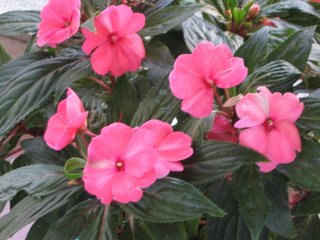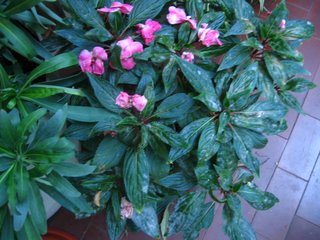 While I was on holiday, I spent a lot of time wandering around and looking at other people’s balconies, in search of ideas. We were in a small seaside town in the north east of Italy (head for Venice and keep going east towards Slovenia), an ex fishing village where tourism is now the main industry. There were loads of hotels and restaurants with container plants growing out front on their terraces, as well as lots of private houses and apartment blocks. These hibiscus, and lots more like them, were waiting for me as I left our hotel every morning.
While I was on holiday, I spent a lot of time wandering around and looking at other people’s balconies, in search of ideas. We were in a small seaside town in the north east of Italy (head for Venice and keep going east towards Slovenia), an ex fishing village where tourism is now the main industry. There were loads of hotels and restaurants with container plants growing out front on their terraces, as well as lots of private houses and apartment blocks. These hibiscus, and lots more like them, were waiting for me as I left our hotel every morning. 
The one plant you couldn’t miss was Dipladenia. It was everywhere and clearly flourishing in the hot, sunny conditions. I love it. I’m never sure whether Dipladenia and Mandevilla are the same plant or different. Some books seem to list them together, others separately. I always think of them as different. I really wanted to get a Dipladenia this year, but couldn’t find it in my local garden centre and got a Mandevilla instead (see Aug 6).

As well as looking at individual plants though, I was also looking at colour schemes, with my Aug 9 post in mind. A lot of people had gone for one colour and one plant only. They often looked great, but I always had the feeling that there was a “businessperson” behind them, more interested in making his or her premises look attractive than really having any real interest in gardening.
The same was true of some of the bi-coloured arrangements too, though I have to admit that the mass of purple and white surfinias on all the balconies of this hotel was pretty impressive.

In general though, my favourites were the less obvious combinations. This pairing of blue plumbago and red begonias was nice, and I fell in love  with the violet flowers and bi-coloured leaves of this hebe paired with the deep, deep red of these pelargoniums.
with the violet flowers and bi-coloured leaves of this hebe paired with the deep, deep red of these pelargoniums.
But of all the combinations, this little corner in the old part of the town was the one that really won me over. There’s nothing unusual about either the colour scheme or the plants, but they just looked so happy and full of life that I couldn’t resist them. They’re now on my computer desktop, and greet me every day as I struggle, very reluctantly, to get back to work ….







